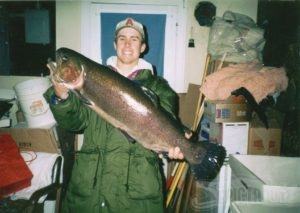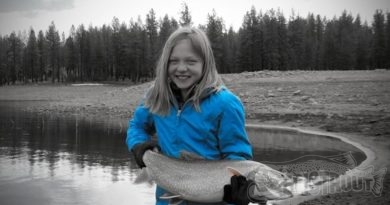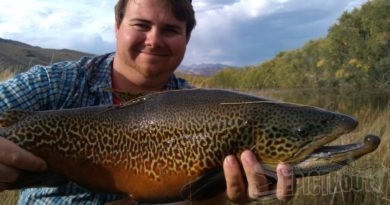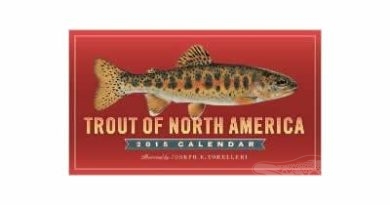Truck Trout
Planters, hatchery, round tails, alpers, brooders, triploids, super trout, truck trout… I have heard them called many things. Often times we disregard the lowly hatchery trout but how many of us have smiled with glee while watching one hit our panther martin? This article is an ode to the often disrespected hatchery trout… pellet raised in a concrete tank and engineered to be caught by anglers for table fare.
It was an early foggy morning on a tiny little lake in Oregon called Willamina Pond . I decided to walk around the lake to scout for some good looking water. As I made my way through the mist I noticed a sign that said “Danger, beware of Crocodile”. Crocodile??? What the heck? I moved a little slower and my glances were more furtive after that revelation. I learned later that someone had released a pet alligator into the pond and it supposedly had taken up residence and was getting bigger. Thankfully I never had a chance to see if this alligator actually existed.
The pond looked pretty shallow until I got to a deep looking cove and decided this was the place to try for some of the giant brood trout that I had been tipped off were stocked the day before. A friend of a friend knew the stocking coordinator for this area and the Oregon Department of Fish and Wildlife had dumped oodles of monster trout into the tiny pond. As I strung up my rod I saw a huge boil out in the middle of the cove. My hands shook with anticipation.

I tied on a tried and true gold kastmaster… my go to lure of choice for big brooder rainbows. It took a few casts to settle in but eventually I had that ¾ oz. hunk of metal arching far out into the lake. On around the 10th cast I saw what I thought was a slight disturbance behind my lure. I didn’t feel anything so I shrugged it off as my imagination. I decided to make another cast that would duplicate the path of the previous cast just in case it actually was a fish.
When my lure was about halfway in, I saw that same disturbance and this time it turned into a v-wake that followed directly behind my lure. The wake was enormous! I kept the lure moving at a fish catching clip and the wake built until I could actually see a huge, dark shape directly behind my lure as it approached shore. Suddenly the beast opened its ginormous maw and my lure disappeared. By now the fish was in maybe 2 foot of water and when I set the hook he literally exploded in what could only be described as a monstrous boil as he tried to turn for deeper water. He got some traction and pulled out 100 feet of line in a sizzling run. At the end of the run my rod bowed as he tried some huge headshakes to dislodge the lure.
I battled the beast for around 10 minutes or so on 6 pound test before I finally slid him into the net. These were hatchery fish that were meant to be kept and eaten and I gladly obliged. I was surprised to find the meat was in great shape when I filleted it and it tasted great cooked in tin foil with some butter and onions. This fish was my license dollars at work and I was a happy camper.
I could tell many stories, as I am sure you could too, about drifting some pautzkes green labels into deep holes on your favorite childhood stream and pulling out some nice planted rainbows. You may have visited trophy stocked lakes like Amador, Irvine and Santa Ana River Lakes. We often think that hatchery fish are very easy to catch but that is not always the case. I remember having to use gossamer thin two pound test for the wary monsters that roamed Irvine Lake in the late 1980s. I have been humbled many times by the “lowly” hatchery trout.

One of the neatest things I ever got to do while working for ODFW was to hand feed some big trout at one of the coastal hatcheries. I never grew tired of watching them effortlessly balance in the water and perfectly time their movements to take the food. I think you all would agree that trout are amazing creature no matter how they were raised.




